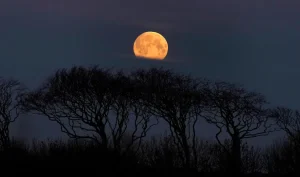Russia’s Luna-25 Crashes Into The Moon: All Mission UPDATES
20th Aug 2023
Russia is attempting to place a lander on the lunar surface before India’s Chandrayaan-3 arrives. Orbital Today will keep you abreast of developments as they unfold.
Update 2, 20th August: Luna-25 lander assumed crashed into Moon’s surface
In an update to its 19th August announcement that the Luna-25 lander had malfunctioned, Roscosmos stated on 20th August via Telegram that the lander has ‘ceased to exist’. The announcement follows a study of data based on the lander’s actions after being given the command to enter pre-landing orbit. Roscosmos stated that the lander had switched to ‘an off-design orbit’.
Update 20th August: Luna-25 Lunar Lander malfunctions
The lander module for the Luna-25 project is under diagnosis, according to the Russian space agency Roscosmos. The agency has not announced what the issue is or whether it will negatively impact the lander’s meeting with the surface of the Moon. In a 19th August announcement on Roscosmos’ Telegram social media channel, the agency noted that the command for the spacecraft to move into pre-landing orbit was sent, but that something happened onboard the lander, ” which prevented the maneuver from being performed with the specified parameters.”
Update 17th August: Luna-25 Moon Lander Captures 1st Photo of Lunar Surface
Shared by Russian space agency Roscosmos on 17th August 2023, the detailed image focuses on the Zeeman crater situated in the remote hemisphere of the moon, near its southern pole.

What You Need to Know
Russia is launching its 1st moon mission since 1976 Luna-25. Here are the key facts about Russian lunar mission and how is it different from India’s Chandrayaan-3.
After a gap of 47 years, Russia is gearing up to launch its spacecraft to land on the Moon. This launch is set to happen on 11th August. Luna-25’s lunar touchdown is pretty close to that of India’s Chandrayaan-3, which took off about a month ago. This sets the stage for a fresh competition: a race to see who can reach the Moon’s south pole first. Let’s take a closer look at what we know about these missions and try to figure out who might take the lead in this new space race. Also, does Luna-25 point to the dawn of an era of lunar geopolitics?
Russia’s First Lunar Lander since 1976: Luna-25 Mission

Russian aerospace firm NPO Lavochkina has announced the completion of the Luna-25 spacecraft. The mission is designed to achieve a soft landing on the Moon’s surface, specifically targeting the lunar south pole. This region holds a particular intrigue due to its potential ice deposits. The spacecraft will spend approximately one Earth year on the lunar surface, conducting contact studies of the lunar soil in this area and investigating the presence of ice and other valuable resources.
Lunar landers deployed by Russia’s forebear, the Soviet Union, targeted the Moon’s equatorial regions. However, Luna-25 aims to land near the Boguslavsky crater in the challenging lunar south pole area. It carries around 31 kilograms of scientific equipment, including instruments to extract rock samples from depths of up to 15 centimeters. These samples will be scrutinized for traces of water, a vital resource for future crewed lunar missions. The spacecraft, with a mass of 1.8 tons, is significantly smaller than its predecessors but packs advanced technology for its tasks.
Sanctioned Luna-25
The lunar initiative encountered delays spanning nearly two years. Initially planned in partnership with the European Space Agency (ESA), the progression of Luna-25 faced disruption due to the Russian invasion of Ukraine in February 2022. This ruptured relations between Europe and the Russian space agency, Roscosmos.
This diplomatic upheaval led to ESA’s withdrawal from the Luna 25 undertaking, as well as follow-up missions Lunas 26 and 27. Russia has managed to substitute European components on the lander with domestically manufactured ones.
Evacuation of the entire town before Luna-25 launch
According to a recent report from Reuters, the Russian government has made plans to evacuate the entire town of Shakhtinskyi on 11th August in anticipation of the upcoming Luna-25 launch. This small town is situated in the Khabarovsk region of Russia and located to the southeast of the launch site. The decision stems from its positioning within the projected area where the separated boosters of the Soyuz rocket are expected to drop after detachment from the spacecraft.
When will Luna-25 land on the Moon?
Roscosmos claimed that its Luna-25 spacecraft would take five days to fly to the moon and then spend five to seven days in lunar orbit before descending on one of three possible landing sites near the pole. The landing of Luna-25 is planned on 21st August. This timeline indicates that Russia’s mission could reach the lunar surface around the same time as or shortly before the Indian mission.
On 5th August, the Chandrayaan-3 spacecraft entered the Moon’s orbit and began sending its first images. Chandrayaan-3 is taking a longer route that takes advantage of the gravities of the Earth and the Moon to use a lot less fuel.
Luna 25 vs Chandrayaan-3 mission differences

There are a lot of differences between these two missions, starting from their technological approaches and ending up with their budgets.
Scientific Objectives
The Luna-25 mission aims to study the composition of the lunar polar regolith (surface material) and the plasma and dust components of the lunar polar exosphere, according to NASA. Meanwhile, Chandrayaan-3 aims to demonstrate a safe and soft landing on the lunar surface, rover mobility, and in-situ scientific experiments, according to Indian Space Research Organisation (ISRO).
Lander Structure
Luna 25’s lander features a four-legged base housing landing rockets and propellant tanks. An upper compartment contains solar panels, communication equipment, onboard computers, and scientific instruments. Chandrayaan-3 consists of an indigenous lander module (LM), a propulsion module (PM), and a rover. The rover is equipped with scientific payloads for chemical analysis of the lunar surface.
Payloads
Luna-25 carries eight science instruments, including gamma-ray and neutron spectrometers, infrared spectrometers, mass spectrometers, and imaging systems. The Chandrayaan-3 lander carries payloads like Chandra’s Surface Thermophysical Experiment (ChaSTE) and Langmuir Probe (LP), while the rover carries instruments like Alpha Particle X-ray Spectrometer (APXS) and Laser Induced Breakdown Spectroscope (LIBS).
Race to the Uncharted
India and Russia find themselves in a time-sensitive competition to achieve a groundbreaking feat: landing on the uncharted terrain of the Moon’s southern pole. The intricate and demanding landscape of this region poses a formidable obstacle. Yet, its allure lies in the scientific potential it holds, largely driven by the anticipation of vast ice deposits—an invaluable resource with extensive implications. This ice reservoir has the capacity to play a pivotal role, serving as a crucial reserve for essentials like fuel, oxygen, and drinkable water, which, in turn, could significantly bolster upcoming endeavours aimed at establishing a sustainable lunar habitat.
Lunar Geopolitics
The sudden race to the lunar south pole raises the spectre of geopolitical similar to that found under the Arctic ice cap on Earth. Russia has increased tensions with its polar neighbours by planting flags by submarine and claiming the pole for Russia. Concerns regarding the lunar surface have already existed in regards to China, but Russia’s attempt to land before India points to the same behaviour.






Thank you for your comment! It will be visible on the site after moderation.